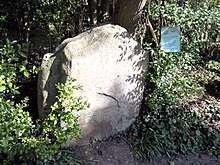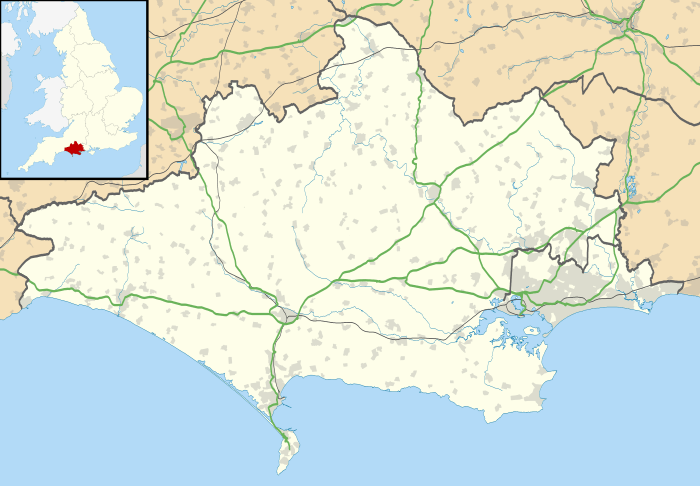Flagstones Enclosure
Flagstones is a late Neolithic interrupted ditch enclosure (similar to a causewayed enclosure) on the outskirts of Dorchester, Dorset, England. It derives its name from having been discovered beneath the site of the demolished Flagstones House.[1] Half of it was excavated in the 1980s when the Dorchester by-pass was built; the rest of it still exists under the grounds of Max Gate, Thomas Hardy's house.
 The "Druid Stone" found at Thomas Hardy's house in 1891, now identified as a sarsen stone from Flagstones Enclosure | |
 Shown within Dorset | |
| Region | Dorset, England |
|---|---|
| Coordinates | 50.707°N 2.420°W |
| Type | Causewayed enclosure |
| History | |
| Periods | Neolithic / Bronze Age |
The Druid Stone
In March 1891 workmen were digging under the lawn at Thomas Hardy's house at Max Gate when they discovered a large sarsen stone three feet underground.[2] It took seven men with levers to raise the stone which had been lying flat.[2] Around the stone was a quantity of ashes and half-charred bones.[2] Hardy called it "The Druid Stone" and had it erected at the edge of the lawn where it still stands.[3] Hardy would write about the stone in his poem "The Shadow on the Stone".[4] It was only when the enclosure was discovered in the 1980s that it was realised that the sarsen stone came from a larger monument.[3]
Excavations
Around half of the enclosure was excavated in 1987–8.[5] The part of the enclosure in the grounds of Flagstones House was excavated by Wessex Archaeology, and then the grounds were totally removed to make a deep cutting for the Dorchester by-pass road.[1] The other half still exists under the grounds of Max Gate.[1]
The enclosure comprised a circular ring of unevenly spaced pits constructed in the late 4th millennium BC.[5] The chalk walls of some of the pit/ditch segments featured engraved designs, probably cut with flint.[5] An adult cremation and two child inhumations were found at the bottom of ditch sections, each beneath a slab of sandstone or sarsen.[5] A young man had been buried in a later Early Bronze Age tumulus in the centre of the enclosure.[5] Carbon dating of the remains put the building of the enclosure at around 3486–2886 BC with the central burial dating to around a thousand years later.[1] The central mound seems to have subsequently acted as a focus for much flint-knapping.[5]
A large henge enclosure known as Mount Pleasant henge lies around 500 metres to the east, whereas Maumbury Rings lie about 1500 metres to the west.
References
- Flagstones Enclosure at the Megalithic Portal, accessed 13 April 2015
- Hardy, Thomas; Hardy, Florence. The Life of Thomas Hardy. Wordsworth. pp. 240–1. ISBN 1840225599.
- Millgate, Michael (2006). Thomas Hardy: A Biography Revisited. OUP. p. 240. ISBN 0199275661.
- Mezey, Robert (1998). Hardy: Selected Poems. Penguin. p. 231. ISBN 0140436995.
- Historic England. "Flagstones Enclosure (983955)". PastScape. Retrieved 13 April 2015.
Further reading
- Roland J. C. Smith, 1997, Excavations along the Route of the Dorchester Bypass, Dorset Wessex Archaeology Report